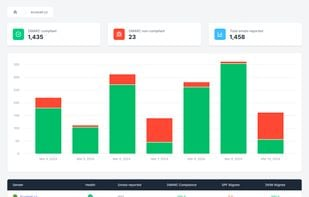Feature set
DMARCEye presents a strong, self-serve DMARC reporting and analysis platform. Its dashboard provides an intuitive overview of email authentication status, making it straightforward to identify authentication failures and legitimate sending sources. We found its core DMARC report analysis to be quite robust, allowing users to drill down into data for detailed insights.
The platform excels in source detection, helping us pinpoint where our emails are originating. While it offers good reporting capabilities, the focus is largely on DMARC itself, with less emphasis on broader email deliverability aspects like comprehensive blocklist (or blacklist) monitoring or advanced DNS management beyond DMARC, SPF, and DKIM. Its AI-powered monitoring aims to simplify complex data interpretation.
spfXio, on the other hand, positions itself as a managed service, meaning its feature set is less about direct user interaction with a dashboard and more about their team handling the complexities for you. We observed that the core DMARC report management, SPF record management, and DKIM record management are central to their offering, with their team actively making the necessary adjustments.
While their system provides reporting history, the granularity of direct, self-service source and spoof detection might be less visible to the end-user compared to a pure DMARC reporting tool. Their value lies in offloading the entire DMARC implementation and maintenance process, including SPF flattening, rather than providing an extensive array of user-facing tools for deep-dive analysis.











































 4.5 / 5(1)
4.5 / 5(1)
 0 / 5(0)
0 / 5(0)



